September at Pillar Kids!
The month of September is “All About Me” at Pillar Kids! This is an exciting theme for us, as we have a chance to celebrate the uniqueness of each child in our preschool. By learning about each other’s interests, abilities, and backgrounds, we promote friendship, empathy, and a sense of belonging.
Toddler Group (Ms. Lam’s group)
The toddler class spent time focused on emotions and how emotions help us express ourselves. In circle, Ms. Lam asked the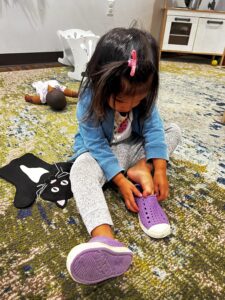
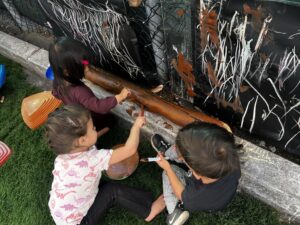 toddlers about what makes them feel “happy” or “sad”. She heard responses like “mommy and daddy make me happy”. One friend said, ”Ate” makes him happy. “Ate” means sister in his home language. The group spent extra time practicing self-help skills such as putting on their own shoes and socks. They had to try it on their own before Ms. Lam would come help.
toddlers about what makes them feel “happy” or “sad”. She heard responses like “mommy and daddy make me happy”. One friend said, ”Ate” makes him happy. “Ate” means sister in his home language. The group spent extra time practicing self-help skills such as putting on their own shoes and socks. They had to try it on their own before Ms. Lam would come help.
One of our favorite activities involved students making a self portrait, where the students look at themselves in the mirror, observing their own face and then trying to recreate what they see. This activity helps to develop fine motor and observation skills as they focused to re-create their own self-image.
Here are some of the songs, books, and rhymes the children enjoyed:
- “The Great Big Cat and The Teeny Tiny Mouse” finger puppet play
- Llama Llama Red Pajama, by Anna Dewdney
Preschool Group (Ms. Angelina’s group)
The preschoolers started off similar to the toddlers, by creating self portraits. They began by taking a closer look at themselves in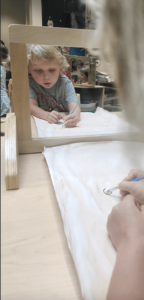
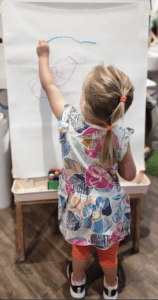 the mirror, each child noticing their own skin tone and those of their friends. Next, they examined their own facial features and then, in stages, drew and painted a self-portrait. The students also spent time discussing the concept of family. As a group the children also compared and contrasted their family dynamics, talking about who makes up each of their families, and where we live. We looked at homes around the world and learned how people live in different types of homes, some made of wood, brick, straw and mud, etc. This is part of what makes us unique as individuals. Finally, they took a closer look at what makes up the human body, the purpose of our skin, bones, and things like hair, eyelashes, nostrils, and belly button, to name a few.
the mirror, each child noticing their own skin tone and those of their friends. Next, they examined their own facial features and then, in stages, drew and painted a self-portrait. The students also spent time discussing the concept of family. As a group the children also compared and contrasted their family dynamics, talking about who makes up each of their families, and where we live. We looked at homes around the world and learned how people live in different types of homes, some made of wood, brick, straw and mud, etc. This is part of what makes us unique as individuals. Finally, they took a closer look at what makes up the human body, the purpose of our skin, bones, and things like hair, eyelashes, nostrils, and belly button, to name a few.
Here are some of the songs, books, and rhymes the children enjoyed:
- I Wonder Why I Blink, by Bridget Avison
- Shades of People, by Rotner and Kelly
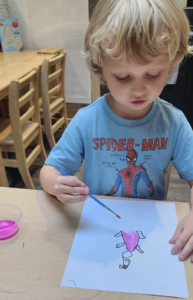
- We Are All Alike…We Are All Different, by Cheltenham Elementary Kindergartners
- Houses and Homes, by Morris and Heyman
- The Family Book, by Todd Parr
Incorporating self-portrait activities into a preschool curriculum can be an enriching and holistic experience that encompasses artistic, emotional, and cognitive development. It encourages children to celebrate their individuality and creativity while fostering important life skills including:
- Self-Expression: Self-portraits allow preschoolers to express themselves creatively. They can use colors, shapes, and various art materials to represent how they see themselves, promoting self-expression and imagination.
- Self-Recognition: Through the process of creating self-portraits, children become more aware of their physical features and learn to recognize themselves. This helps in building a strong sense of identity.
- Fine Motor Skills: Drawing and painting self-portraits involve intricate hand-eye coordination, which helps develop fine motor skills. The act of holding and using art tools enhances their dexterity.
- Observational Skills: To create an accurate self-portrait, children need to observe their facial features closely. This promotes their observational skills, attention to detail, and spatial awareness.
- Emotional Expression: Preschoolers may use their self-portraits to convey emotions, which can be a helpful tool for them to express and communicate their feelings. This can be particularly beneficial for children who may find it challenging to articulate their emotions verbally.
- Boost in Self-Esteem: As children complete their self-portraits and see their creations, they gain a sense of
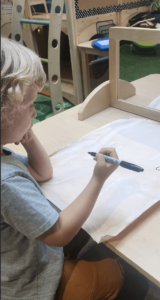 accomplishment and pride. This can boost their self-esteem and confidence.
accomplishment and pride. This can boost their self-esteem and confidence. - Body Positivity: Self-portraits can help children appreciate and accept their physical appearances. This promotes a positive body image and self-acceptance from an early age.
- Social and Language Skills: Preschoolers often discuss their self-portraits with teachers and peers. This encourages social interaction and the development of language skills as they describe and explain their artwork.
- Sense of Ownership: Children feel a sense of ownership over their self-portraits. This fosters a sense of responsibility and pride in their creations.
- Family Engagement: Self-portrait activities can extend to involve families. Parents and caregivers can encourage and support children in this creative process, strengthening family bonds.
- Cultural Awareness: Children may use self-portraits to represent their cultural background, fostering an understanding and appreciation of diversity among peers.
- Memory and Reflection: Self-portraits can serve as memory markers. They allow children to look back and reflect on how they saw themselves at a particular point in time, promoting self-awareness and personal growth.

